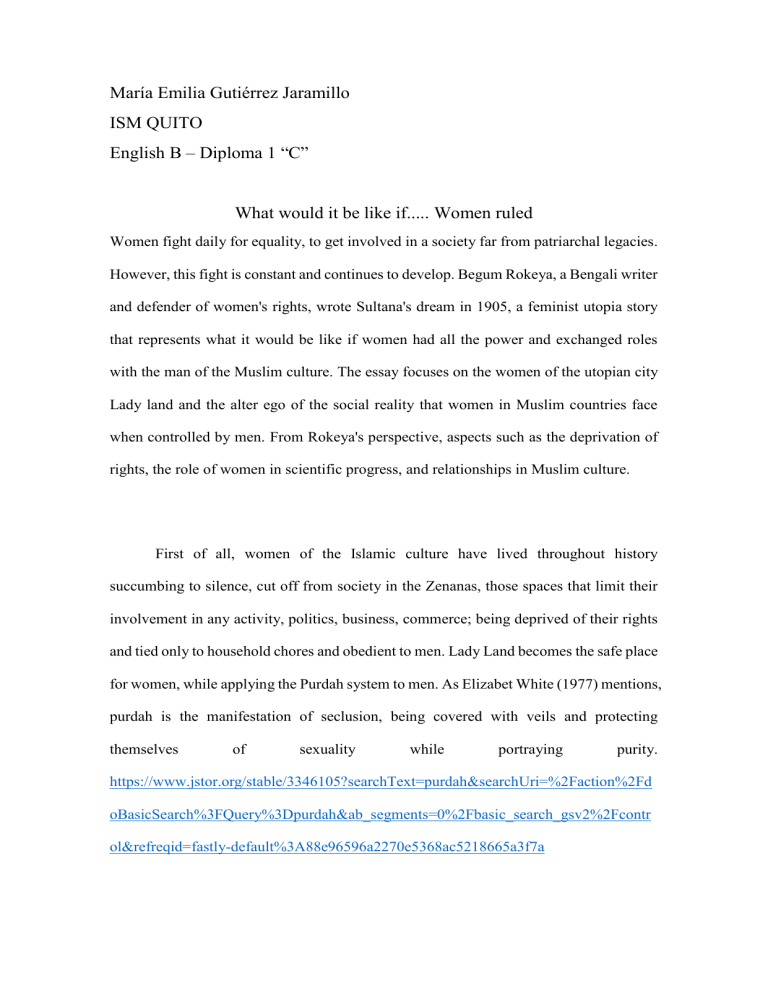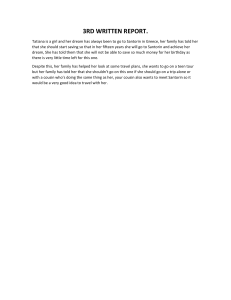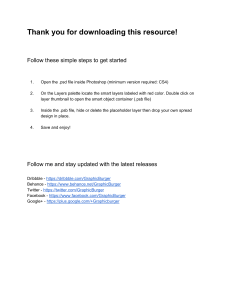
María Emilia Gutiérrez Jaramillo ISM QUITO English B – Diploma 1 “C” What would it be like if..... Women ruled Women fight daily for equality, to get involved in a society far from patriarchal legacies. However, this fight is constant and continues to develop. Begum Rokeya, a Bengali writer and defender of women's rights, wrote Sultana's dream in 1905, a feminist utopia story that represents what it would be like if women had all the power and exchanged roles with the man of the Muslim culture. The essay focuses on the women of the utopian city Lady land and the alter ego of the social reality that women in Muslim countries face when controlled by men. From Rokeya's perspective, aspects such as the deprivation of rights, the role of women in scientific progress, and relationships in Muslim culture. First of all, women of the Islamic culture have lived throughout history succumbing to silence, cut off from society in the Zenanas, those spaces that limit their involvement in any activity, politics, business, commerce; being deprived of their rights and tied only to household chores and obedient to men. Lady Land becomes the safe place for women, while applying the Purdah system to men. As Elizabet White (1977) mentions, purdah is the manifestation of seclusion, being covered with veils and protecting themselves of sexuality while portraying purity. https://www.jstor.org/stable/3346105?searchText=purdah&searchUri=%2Faction%2Fd oBasicSearch%3FQuery%3Dpurdah&ab_segments=0%2Fbasic_search_gsv2%2Fcontr ol&refreqid=fastly-default%3A88e96596a2270e5368ac5218665a3f7a The background of the story highlights the reality of women in the idea of the role inversion. Sister Sara, as a host, is the representation of man in the real world while in Lady land she remains firm in how men correspond indoors with the aim of controlling them after being compared to wild animals, without thought and prohibited from relating or giving an opinion. As stablished by Rokeya, Indian women living conditions were no better than those of a slave, they resembled confinement in inferiority, being prey to fear and obedient to patriarchy, where men were their lords and masters. The alternative version promotes the empowerment of women, eliminates restrictive practices to be capable of social progress where they work less but effectively and have time for other activities as men are submissive in charge of cooking and cleaning. Hossein portrays the understanding that misogynist ideas are associated with low morals, for which the solution according to Ladyland's ideology is the imprisonment of men and elimination of mental slavery of ignorant women, to achieve freedom. https://www.jstor.org/stable/41856562?read-now=1&seq=6#page_scan_tab_contents https://www.academia.edu/35410462/Lloyd_Price_Feminist_science_fiction_as_resista nce_An_essay_on_Rokeya_Sakhawat_Hossain_s_Sultana_s_Dream_1905_ Secondly, scientific progress rises to the satire of reality in Muslim culture although it also refers to the modern world's improvements on women. The way we see this is through feminism in science fiction in a critique of male violence. Feminist science expands its connection with nature, in favor of collective well-being, advances that dictate peace instead of evoking war. Islam does not forbid education, however, the wrong application of it in cultural gender roles that extremist authoritarian regimes enact, prevent female participation, but in return as a consequence allow women to fight for a role in society. Islam Doesn't Deny Women Education, So Why Does the Taliban? (vogue.me) Fortunately, under the rule of the queen of lady land, a united nation was formed that avoided war through its technological advances, creating solar panels that harvested energy to use in cooking and even balloons that could draw water from the atmosphere avoiding storms and being a storage source. It was more important to take into account that intellectual capacity, such as increasing brain power, contained more weight than masculine physical strength, which only led to wars rather than to a dialogue of conflicting resolutions. This is how in the story women are portrayed as symbols of peace, evidenced through the dialogue between the characters "As you Gained a decisive victory without shedding a single drop of blood, you could drive off crime and criminals too without much difficulty". Definitely, it proves that women are visionaries in the search for detoxification of the superiority of men, recognizing that they can have the same or greater capacities and be efficient in social progress without violence. Visiones feministas de la ciencia y la utopía en el "sueño de la sultana" de Rokeya Sakhawat Hossain — Lady Science Third, under the concept of Rokeya, fragments of the way in which women relate to men in Muslim culture are shown under the beliefs of the Islamic religion and in its alternative version through truth and love. Sultana questions Sister Sara about religion, and Sister Sara replies that it is based on love and truth, challenging kinship relations as an anti-purdah system. For women in real world society, the prohibition/illegality of marrying or even showing affection to close blood or marriage relatives (in-laws) as well as breastfeeding ties are governed under the "Mahram". For this reason, the use of the hijab with men who are not mahram is mandatory since they encourage them to be "modest" in addition to avoiding provoking men and reserving themselves for their husbands. https://www.jstor.org/stable/43031047?read- now=1&seq=4#page_scan_tab_contents On the contrary, in the feminist utopia, love and truth reign. On that, the sacred circle is wide, going beyond close relatives, even distant family is sacred, enhancing a pure nation free from the corruption of carnal desire. "It is our religious duty to love each other and be absolutely truthful", justice is carried out without death, in harmony and with respect, although we are conflicting social beings, morality makes us reflect, recognizing our most human side. Finally, the relationship between men and women no longer presents limits, destroying hierarchies giving the freedom to leave purdah, this favors women's access to public spaces and work, valuing their contribution to sustainability in coexisting with nature in instead of exploiting it. In conclusion, Sultana's dream is a critique of the unequal treatment of women within a society governed by patriarchal Islamic law. Firstly, Rokeya demonstrates the living conditions of women in the deprivation of rights through role reversal with men. Second, imparting pacifist ideologies without physical strength but through scientific progress, eliminating cruelty and living together in harmony. Third, the way of relating is sacred but it seeks to face the stigmatization of purdah in order to relate healthily and with a mentality of purity without restricting women. Reading sultana changes our perspective, although it is only a dream from which Sultana once again returns to the ordinances of men, it encourages women to be agents of change, to seek opportunities and to be recognized for their individuality, capable of creating and producing, but especially that they break the chains of oppression. Singh, N., & Ahmed, R. (2012). MUSLIM WOMEN AND HUMAN RIGHTS. The Indian Journal of Political Science, 73(1), 73–84. http://www.jstor.org/stable/41856562 White, E. H. (1977). Purdah. Frontiers: A Journal of Women Studies, 2(1), 31–42. https://doi.org/10.2307/3346105 Price, L. (2017, 12 diciembre). Lloyd Price, Feminist science fiction as resistance: An essay on Rokeya Sakhawat Hossain’s Sultana’s Dream (1905). https://www.academia.edu/35410462/Lloyd_Price_Feminist_science_fiction_as_resista nce_An_essay_on_Rokeya_Sakhawat_Hossain_s_Sultana_s_Dream_1905_ Lodi, H. (2021, 26 septiembre). Islam Doesn’t Deny Women Education, So Why Does the Taliban? Vogue Arabia. https://en.vogue.me/culture/afghanistan-taliban-womenschool-ban/ Lewton, T. (2019, 12 agosto). Feminist Visions of Science and Utopia in Rokeya Sakhawat Hossain’s ‘Sultana’s Dream’. Lady Science. https://www.ladyscience.com/features/feminist-visions-science-fiction-utopia-rokeyahossain Mazumdar, S., & Mazumdar, S. (2001). RETHINKING PUBLIC AND PRIVATE SPACE: RELIGION AND WOMEN IN MUSLIM SOCIETY. Journal of Architectural and Planning Research, 18(4), 302–324. http://www.jstor.org/stable/43031047





